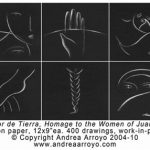The Business of Art: A Conversation with Dana Frankfort and Wendy White
Dana Frankfort: Anyone who can put a soccer ball in front of a painting and make it seem completely natural is up to something interesting. When I first saw Wendy’s work, I couldn’t wait to see where things would go. Since then she’s continued to grapple with a certain kind of odd logic that ends up making total sense, an effortless parity between canvas and subject-elements that I think every painter is involved with in some way. There is a very sophisticated method to her madness.
Wendy White: I first encountered Dana’s work at her 2006 solo show at Kantor/Feuer in Los Angeles. A year later, we were both in the group show Late Liberties at John Connelly Presents here in New York. Her paintings struck me then as fresh and extremely witty, yet hard-won, and I continue to admire her no-holes-barred, blatant assault on the single word. It was a pleasure to speak with her here about our common ground.
Wendy White: What space or spaces influence your paintings?
Dana Frankfort: I’ve been looking at Easter Island and Stonehenge—thinking about standing stones as if monoliths are letters that stand in relation to one another. I do that kind of visualization. But then painting directly from the landscape does the trick too. Sometimes I’ll incorporate text into observational paintings of the landscape.
WW: I like the idea of letters as monoliths or figures. I’m really drawn to the letter R. I think it’s the sturdiest letter, and the most personified. Do you ever change the word you’re painting as dictated by the formal structure, or do you stay true to your initial impulse? How do you decide what’s legible or illegible?
DF: I think of myself as an abstract painter—lines, color, space, all the elements of composition. I’m interested in the formal and linguistic elements of the painting being in “balance,” but not in being able to “read a word.” My favorite letter is E. I think it’s interesting to extend the horizontal lines of the E as long as the canvas will allow, until the letterform gives way to the brush marks.
Do you try and make letters and text in your paintings legible?
Dana Frankfort
LIFE (2010)
Oil and acrylic on canvas, 5 x 7’
WW: Yeah, but I usually end up with gibberish, or abbreviations. I like handmade signs, where someone tried to fit all the info but ran out of room and things are all squished in. You assume they would have preferred it to fit but they just went with it anyway. In a lot of your paintings, like People (2009) and Things (2009), it seems the negative space is putting physical pressure on the word; background versus negative space.
DF: I’m obsessed with negative space, especially when it’s confused with positive space. There’s the space between things, and then there are the things. An example of positive and negative space really being pushed is an Ellsworth Kelly show last year. He stuck one painting on top of another: a monochrome painting with another monochrome painting attached to it, which made the wall appear to be the third monochrome painting. It was really amazing.
WW: Those are cool paintings and with that show he found ways to challenge the notion of “format” and “presentation” without committing to “object.” Very few painters have managed to explore that space without suffocating it with minimalist rhetoric. Your monochromatic palettes…are they intentional or unintentional?
DF: It’s a tendency. Can you talk about your use of white?
WW: With a lot of white the painting can bleed onto the wall and vice versa.
DF: That reminds me of Robert Irwin’s disc paintings. Why single panels versus multi panel?
WW: Having them be pseudo-modular is more modern and site-specific. I want them to take up a lot of space without being “large-scale paintings.” Does that make sense? I don’t care about illusion, so making huge paintings with the notion that you can “walk into them” only interests me on a really superficial level. Do you care about illusion in painting?
DF: Not so much, at least not intentionally. But wait, I want to hear your thoughts about monochrome versus multicolor.
WW: I use a lot of black and white, but never without major doses of color. I neutralize toxic palettes with empty space and areas of dry brush that are like the marks left over when you scratch a surface unintentionally.
Wendy White
Ranc (2009)
Acrylic on canvas, 61½ x 57½”
DF: Erase or paint over?
WW: Neither. My marks are one-offs. It’s really the only thing that’s non-negotiable for me.
DF: So when you think a painting doesn’t work, do you tend to trash it or save it?
WW: Trash it. You?
DF: Save and deal with it later.
What have you been reading lately?
WW: Nothing recently. I go through phases. Honestly, literature is really inconvenient to me right now. As far as art material, I gravitate toward the nonacademic.
DF: I totally agree. Are you more into interviews or critical essays?
WW: Interviews. I noticed in your studio that you have this great catalog of obscure ’80s paintings. I hadn’t heard of most of the artists. What was the show? It was both exhilarating and depressing to see such experimental work falling into a historical abyss.
DF: It’s a show of the “hot painters” from the ’80s. I bought it in the sale bin at The Strand. I love that 99 percent of the artists in the book are pretty much off the radar today. It’s a nice reminder of how ephemeral it all is.
Here’s something I think about a lot—art school: effective or overrated?
WW: Both. Depends on where you go, how impressionable you are, and who you study with. I think most of the time a formal education can take you further, but some artists end up paralyzed by all the rules they think they have to follow. In undergrad I was a fibers major and that’s made me a much more materials-oriented painter. What has been your experience?
DF: My experience as a student and a teacher in art school is that it’s a great time to battle with who you are and with who you’re supposed to be.
What about irony versus sincerity?
WW: Irony’s usually more interesting, but I don’t know, they’re kind of the same thing these days, aren’t they?
DF: Perhaps it’s something dictated by the viewer. Painting as object or as image?
WW: I’m about 70/30 in favor of object.
DF: Yeah, me too. Finished or unfinished?
WW: I think finishing is a momentum killer. I think I just get temporarily satisfied and stop. Your paintings have this uncanny sense of finish without ever being fussy. I think it’s the visible brushstrokes, the work that is all in service to the image, yet never looks “set.” Am I way off-base? Does that phrase “in service to the image” freak you out?
DF: “In service to” anything kind of freaks me out. But with painting, yes my decisions are in service to the image/object.
How do you approach the titles of your paintings? Title or no title?
WW: Title. What I want is sort of an “associative riff” on verbiage. What I often end up with is a made up word or phrase that represents both the interior result of my painting process and a kind of exterior sign that takes on its own life. I noticed that you usually title your paintings after the word you’ve painted. Do you ever think of language as a manifestation of power? I like that it seems you’re willing to let the word win.
DF: I’m interested in the tension between the power of the word linguistically and formally, what it can do on its own as a painting. I don’t put too much thought into the titles of my paintings—whatever “word” is painted last becomes the title, whether or not the word is legible.
Dana Frankfort
WATERCOLOR (NUTS) (2010)
Oil on panel, 5 x 6’
Who is part of your painting family tree?
WW: Warhol and Rauschenberg, with Jim Dine’s tool paintings as some kind of embarrassing uncle that nobody wants to talk to at family picnics. Kippenberger and Oehlen are cousins…. and Stockholder and Cady Noland are aunts I lost touch with. Of course there’s Guston. Looking at some of our recent work, you and I have got to at least be cousins, right?
DF: I’d say so!
WW: What about your tree?
DF: Easter Island standing stones are my ancestors. Then there’s Franz Kline, Frederic Remington, Marsden Hartley, and Arthur Dove. My next door neighbors are Georgia O’Keefe, Ellsworth Kelly, and Morris Louis. Al Held, and Frank Stella would be distant cousins. Bernard Piffaretti is that weird life-changing uncle that I’ve just started to get to know.
Chelsea or the Lower East Side?
WW: That sounds like a personality indicator! Both. I love looking at art in a raw space, but I fully admit to being wowed by a white cube installation. What do you prefer for your own paintings?
DF: I’m very interested in paintings as installation—more choices have to be made.
WW: Messy studio or clean studio?
DF: Über messy.
WW: Do you work on one painting at a time or do you have multiple paintings in progress?
DF: Multiple. I definitely paint groups of paintings together.
WW: Wow, I never do that. Maybe that’s why I can’t rework things either.
Reverent or irreverent?
DF: Reverent.
WW: To what?
DF: To myself or the painting. I’m not trying to upend culture in any way. I play pretty close to my instincts.
WW: Any pertinent biographical information?
DF: I ain’t dead yet—Bob Dylan. You?
WW: Um… I have a karaoke machine in my studio.
Dana Franfort received her MFA from Yale University, attended Skowhegan School of Painting and Sculpture, and was a Core Fellow at the Glassell School of Art, Houston, TX. She has had solo shows in New York City, Houston, Los Angeles, and Brussels. In 2006 she was awarded a Guggenheim Foundation Fellowship. Frankfort’s work was in a show at La Montagne Gallery in Boston and a group show, Feminist Painting, at The Jewish Museum in New York City. She is an Assistant Professor of Painting at Boston University.
Wendy White lives and works in New York. Her solo exhibition, Up w/Briquette, was on view at Leo Koenig, Inc. through May 22, 2010. Recent solo exhibitions include Feel Rabid or Not, Galeria Moriarty, Madrid, Spain (2009) and Autokennel, Leo Koenig, Inc., New York, NY (2008). Group exhibitions include Platinum Metre, Aschenbach & Hofland, Amsterdam, The Netherlands and Third Thoughts, CCA Andratx Art Centre, Mallorca, Spain.




